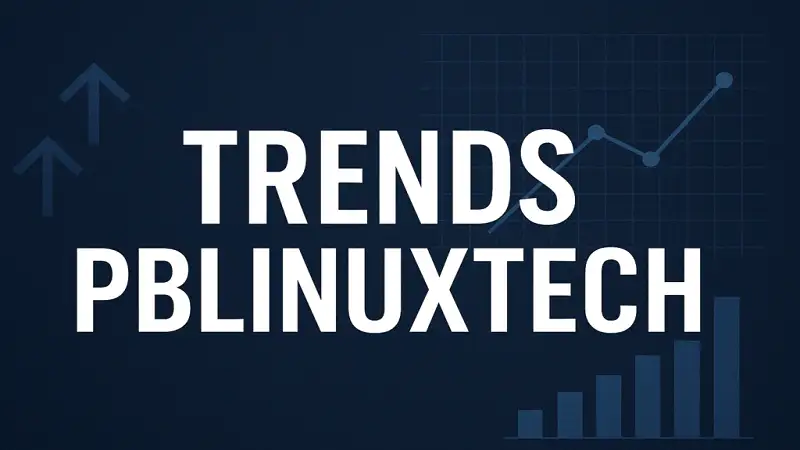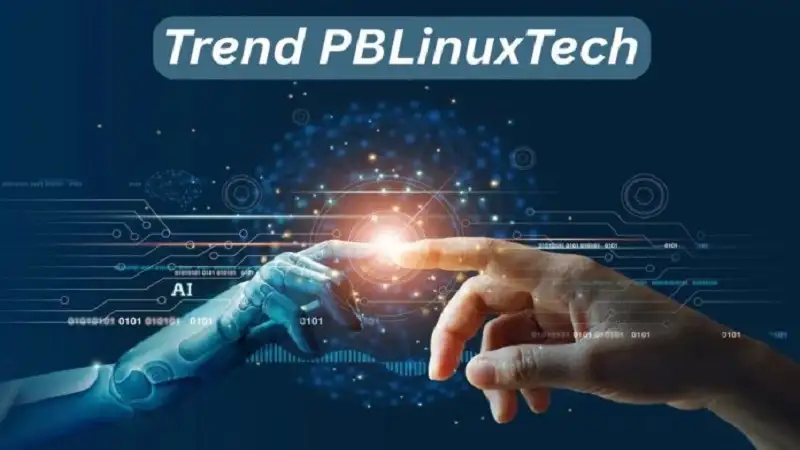Technology has become the backbone of modern society, shaping everything from how we communicate to how we conduct business and even how we live our daily lives. Innovation is constant, and the systems that seemed advanced yesterday are often outdated today. Among these changes, trends pblinuxtech stands out as a comprehensive approach to embracing open-source solutions, cloud technologies, cybersecurity, automation, and sustainability.
The importance of understanding these trends lies in their universal impact. Whether it’s a multinational corporation, a small business, a government agency, or an individual professional, staying aligned with modern technological shifts is essential for growth, competitiveness, and resilience in a fast-changing digital era.
Understanding the Concept of trends pblinuxtech
At its core, trends pblinuxtech represents a convergence of Linux-powered solutions, cloud platforms, automation tools, and innovative digital practices. The idea focuses on adopting flexible, transparent, and community-driven systems that prioritize efficiency, scalability, and accessibility.
Linux plays a vital role because of its adaptability—it powers everything from servers and supercomputers to mobile devices and embedded systems. Businesses rely on Linux distributions because they are reliable, secure, and cost-effective compared to proprietary operating systems. With digital transformation gaining momentum across industries, this blend of technology has become not just an option but a necessity.
The Role of Open-Source in Driving Innovation
Open-source software is one of the strongest foundations of trends pblinuxtech. Unlike proprietary software, open-source tools provide access to source code, encouraging collaboration and innovation. Developers from around the world can identify vulnerabilities, enhance features, and build entirely new applications that benefit the wider community.
For businesses, open-source solutions cut down costs by eliminating expensive licensing fees. More importantly, they enable freedom from vendor lock-in—a significant challenge when relying on proprietary systems. For educational institutions, open-source provides students and researchers with opportunities to learn and experiment without financial limitations.
The collective intelligence of open-source communities accelerates progress. Every contribution, no matter how small, strengthens the ecosystem and ensures that technology evolves faster, more transparently, and with greater accountability.
Cloud Computing and Hybrid Systems
One of the most visible elements within trends pblinuxtech is the dominance of cloud computing. Enterprises increasingly move away from traditional infrastructure to cloud-based models because of their scalability, cost-effectiveness, and reliability. Linux remains the operating system of choice for many cloud providers, including AWS, Google Cloud, and Microsoft Azure.
Hybrid systems—where private and public clouds work together—are also gaining traction. They allow organizations to strike a balance between security and flexibility. Sensitive data can remain within private infrastructure, while workloads that require scalability can operate on public platforms. This hybrid approach ensures operational efficiency, cost savings, and compliance with regulatory standards.
The future of cloud computing lies in multi-cloud strategies, where businesses integrate services from different providers to minimize risks and optimize performance.
Cybersecurity in the Age of Digital Expansion
As digital systems grow more complex, so do the risks associated with cyber threats. Cybersecurity is therefore a central part of trends pblinuxtech. Open-source platforms like Linux provide an added advantage: transparency. Since the code is publicly accessible, vulnerabilities can be quickly identified and patched by the global community, making these systems highly secure.
Cyberattacks such as ransomware, phishing, and data breaches have the potential to cripple businesses. Proactive measures—like intrusion detection systems, firewalls, and encrypted communication channels—are necessary to defend against these threats. Linux-based tools like iptables, SELinux, and Snort are widely trusted for building secure infrastructures.
By integrating AI into security strategies, organizations can also predict, detect, and respond to cyber threats in real time, further strengthening their defenses.
Automation and Artificial Intelligence
Automation and AI are shaping industries at a speed never seen before. Within trends pblinuxtech, automation is applied in software development pipelines, IT management, and large-scale enterprise operations. Linux provides a stable platform for many of these processes, powering automation tools such as Ansible, Puppet, and Jenkins.
Artificial Intelligence extends these capabilities. AI frameworks like TensorFlow and PyTorch are often deployed on Linux environments due to compatibility, performance, and community support. Businesses use AI to analyze data, forecast trends, and automate customer support systems.
The integration of automation and AI results in faster processes, fewer human errors, and improved productivity, enabling organizations to scale efficiently while reducing operational costs.
Edge Computing and IoT Expansion
Edge computing and IoT (Internet of Things) are increasingly important in the broader scope of trends pblinuxtech. Rather than relying solely on centralized cloud servers, edge computing processes data closer to where it is generated, reducing latency and improving responsiveness.
IoT devices—from smart refrigerators to industrial monitoring systems—often run lightweight Linux distributions. This provides flexibility, customization, and strong community support. In industries such as healthcare, IoT devices powered by Linux collect patient data in real time, enabling faster medical responses. In manufacturing, sensors predict equipment failures, minimizing downtime and increasing efficiency.
This combination of IoT and edge computing is paving the way for real-time analytics, safer operations, and enhanced user experiences.
The Future of Work and Remote Collaboration
The COVID-19 pandemic accelerated the shift to remote work, but the trend continues to grow even after global recovery. Within trends pblinuxtech, this shift emphasizes the importance of secure, reliable, and collaborative tools. Linux-based platforms support virtual desktops, secure VPNs, and encrypted communication systems that ensure remote teams remain productive.
Collaboration tools such as Nextcloud, Mattermost, and Jitsi—built on open-source principles—provide businesses with alternatives to expensive proprietary software. These tools allow teams to communicate, share files, and collaborate in real time without sacrificing privacy or data security.
This technological evolution ensures that the future of work remains flexible, inclusive, and accessible to a global workforce.
Sustainability and Green Technology
Sustainability is no longer optional—it is a business imperative. trends pblinuxtech plays a major role in building environmentally responsible solutions. Linux-based systems are resource-efficient, consuming less energy than many proprietary alternatives. This reduces both operational costs and environmental impact.
Cloud providers are also adopting renewable energy sources to power data centers. Meanwhile, developers are designing software that optimizes energy usage, ensuring that hardware runs more efficiently. These measures contribute to reducing global carbon footprints while aligning with international climate goals.
The rise of “green IT” shows that digital innovation and environmental responsibility can go hand in hand.
Education and Skill Development in pblinuxtech
A growing demand for professionals skilled in Linux, cloud computing, cybersecurity, and automation has led to a global push for education in these areas. As part of trends pblinuxtech, universities and online platforms now offer specialized training and certification programs.
Certifications like Red Hat Certified Engineer (RHCE), Linux Foundation Certified System Administrator (LFCS), and CompTIA Linux+ are highly valued across industries. These credentials prepare professionals for roles in system administration, network engineering, and cybersecurity.
Moreover, open-source projects allow students and early-career developers to gain hands-on experience by contributing directly to real-world software. This not only builds technical skills but also fosters a sense of collaboration and innovation.
Challenges in Implementing trends pblinuxtech

Despite its many advantages, trends pblinuxtech faces challenges that organizations must address to fully realize its potential:
-
Integration with Legacy Systems: Many companies still operate on outdated infrastructure, making integration difficult.
-
Skill Gaps: The shortage of trained professionals remains a barrier to widespread adoption.
-
Evolving Cyber Threats: Hackers continuously develop new attack methods, requiring constant vigilance.
-
Resistance to Change: Shifting organizational culture toward open-source and automation can be slow.
Addressing these challenges requires investments in workforce training, infrastructure upgrades, and the adoption of strong governance models.
Case Studies: Success Stories of trends pblinuxtech
The practical benefits of these trends can be seen across industries:
-
Healthcare: Hospitals use Linux-based AI to detect patterns in patient data, enabling faster and more accurate diagnoses.
-
Finance: Banks rely on hybrid cloud systems powered by Linux for secure, scalable, and compliant transactions.
-
Education: Universities use open-source platforms for cost-effective e-learning, making education more accessible worldwide.
-
Manufacturing: IoT-enabled machinery predicts breakdowns before they occur, minimizing downtime and costs.
-
Government: Secure Linux-based systems are deployed to protect sensitive data and manage national infrastructure.
These success stories demonstrate how adopting open-source and Linux-based technologies creates efficiency, innovation, and security in real-world applications.
Looking Ahead: The Future of trends pblinuxtech
Looking forward, the scope of trends pblinuxtech is expected to expand even further. Developments in quantum computing, blockchain technology, and advanced AI models will integrate with Linux-based systems to build the next generation of digital infrastructure.
Global collaboration will remain a driving force, as open-source communities continue to push boundaries and deliver innovative solutions. Sustainability will also take center stage, with an emphasis on eco-friendly technologies and energy-efficient designs.
Businesses that adopt these trends early will enjoy competitive advantages, from faster growth and stronger security to improved customer experiences and global relevance.
Conclusion
trends pblinuxtech represents a powerful intersection of open-source innovation, cloud computing, AI, cybersecurity, and sustainability. Its significance lies in its universal application—helping governments, enterprises, and individuals embrace the digital future with confidence and efficiency.
The success of these technological shifts depends on collaboration, continuous learning, and forward-thinking strategies. By staying aligned with trends pblinuxtech, organizations prepare themselves not only for current challenges but also for the opportunities of tomorrow. Read More joyeveryday.
